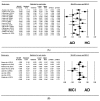Decreased Serum Brain-Derived Neurotrophic Factor (BDNF) Levels in Patients with Alzheimer's Disease (AD): A Systematic Review and Meta-Analysis
- PMID: 30634650
- PMCID: PMC6358753
- DOI: 10.3390/ijms20020257
Decreased Serum Brain-Derived Neurotrophic Factor (BDNF) Levels in Patients with Alzheimer's Disease (AD): A Systematic Review and Meta-Analysis
Abstract
Findings from previous studies reporting the levels of serum brain-derived neurotrophic factor (BDNF) in patients with Alzheimer's disease (AD) and individuals with mild cognitive impairment (MCI) have been conflicting. Hence, we performed a meta-analysis to examine the aggregate levels of serum BDNF in patients with AD and individuals with MCI, in comparison with healthy controls. Fifteen studies were included for the comparison between AD and healthy control (HC) (n = 2067). Serum BDNF levels were significantly lower in patients with AD (SMD: -0.282; 95% confidence interval [CI]: -0.535 to -0.028; significant heterogeneity: I² = 83.962). Meta-regression identified age (p < 0.001) and MMSE scores (p < 0.001) to be the significant moderators that could explain the heterogeneity in findings in these studies. Additionally, there were no significant differences in serum BDNF levels between patients with AD and MCI (eight studies, n = 906) and between MCI and HC (nine studies, n = 5090). In all, patients with AD, but not MCI, have significantly lower serum BDNF levels compared to healthy controls. This meta-analysis confirmed the direction of change in serum BDNF levels in dementia. This finding suggests that a significant change in peripheral BDNF levels can only be detected at the late stage of the dementia spectrum. Molecular mechanisms, implications on interventional trials, and future directions for studies examining BDNF in dementia were discussed.
Keywords: Alzheimer’s disease; BDNF; cognition; meta-analysis; meta-regression; mild cognitive impairment; systematic review.
Conflict of interest statement
The authors declare no conflict of interests.
Figures



Similar articles
-
Peripheral Brain-Derived Neurotrophic Factor Levels in Alzheimer's Disease and Mild Cognitive Impairment: a Comprehensive Systematic Review and Meta-analysis.Mol Neurobiol. 2017 Nov;54(9):7297-7311. doi: 10.1007/s12035-016-0192-9. Epub 2016 Nov 4. Mol Neurobiol. 2017. PMID: 27815832
-
Evaluation of the diagnostic value of peripheral BDNF levels for Alzheimer's disease and mild cognitive impairment: results of a meta-analysis.Int J Neurosci. 2020 Mar;130(3):218-230. doi: 10.1080/00207454.2019.1667794. Epub 2019 Sep 24. Int J Neurosci. 2020. PMID: 31518516 Review.
-
Decreased peripheral brain-derived neurotrophic factor levels in Alzheimer's disease: a meta-analysis study (N=7277).Mol Psychiatry. 2017 Feb;22(2):312-320. doi: 10.1038/mp.2016.62. Epub 2016 Apr 26. Mol Psychiatry. 2017. PMID: 27113997
-
Decreased Neurotrophic Support is Associated with Cognitive Decline in Non-Demented Subjects.J Alzheimers Dis. 2015;46(2):423-9. doi: 10.3233/JAD-150172. J Alzheimers Dis. 2015. PMID: 25737042
-
BDNF, TNFα, HSP90, CFH, and IL-10 serum levels in patients with early or late onset Alzheimer's disease or mild cognitive impairment.J Alzheimers Dis. 2013;37(1):185-95. doi: 10.3233/JAD-130497. J Alzheimers Dis. 2013. PMID: 23948885
Cited by
-
Impact of SARS-CoV-2 Infection on Cognitive Function: A Systematic Review.Front Psychiatry. 2021 Feb 10;11:621773. doi: 10.3389/fpsyt.2020.621773. eCollection 2020. Front Psychiatry. 2021. PMID: 33643083 Free PMC article.
-
Molecular and Functional Characterization of BDNF-Overexpressing Human Retinal Pigment Epithelial Cells Established by Sleeping Beauty Transposon-Mediated Gene Transfer.Int J Mol Sci. 2022 Oct 26;23(21):12982. doi: 10.3390/ijms232112982. Int J Mol Sci. 2022. PMID: 36361771 Free PMC article.
-
BDNF and Pro-BDNF in Amyotrophic Lateral Sclerosis: A New Perspective for Biomarkers of Neurodegeneration.Brain Sci. 2022 May 9;12(5):617. doi: 10.3390/brainsci12050617. Brain Sci. 2022. PMID: 35625004 Free PMC article.
-
Centella asiatica Alters Metabolic Pathways Associated With Alzheimer's Disease in the 5xFAD Mouse Model of ß-Amyloid Accumulation.Front Pharmacol. 2021 Dec 16;12:788312. doi: 10.3389/fphar.2021.788312. eCollection 2021. Front Pharmacol. 2021. PMID: 34975484 Free PMC article.
-
The Influence of Disabilities in Activities of Daily Living on Successful Aging: The Role of Well-Being and Residence Location.Front Public Health. 2020 Jan 28;7:417. doi: 10.3389/fpubh.2019.00417. eCollection 2019. Front Public Health. 2020. PMID: 32047732 Free PMC article.
References
-
- Angelucci F., Spalletta G., Iulio F.D., Ciaramella A., Salani F., Varsi A., Gianni W., Sancesario G., Caltagirone C., Bossu P. Alzheimer’s disease (AD) and Mild Cognitive Impairment (MCI) patients are characterized by increased BDNF serum levels. Curr. Alzheimer Res. 2010;7:15–20. doi: 10.2174/156720510790274473. - DOI - PubMed
Publication types
MeSH terms
Substances
LinkOut - more resources
Full Text Sources
Medical

